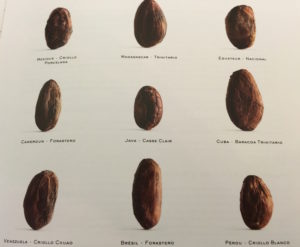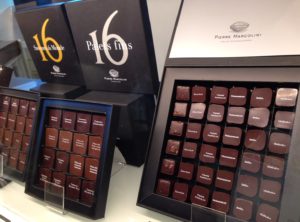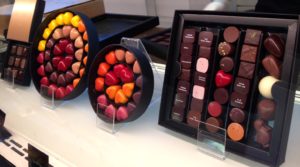6 May 2016
 They say that a picture paints a thousand words. What does this picture mean to you? My initial guess is, probably not much. It was taken at world renowned Pierre Marcolini’s flagship chocolate shop, during my chocolate tour of Brussels last year.
They say that a picture paints a thousand words. What does this picture mean to you? My initial guess is, probably not much. It was taken at world renowned Pierre Marcolini’s flagship chocolate shop, during my chocolate tour of Brussels last year.
This picture is the very essence of chocolate – the cocoa or cacao beans.
When you read the packaging labels on chocolates, especially premium and artisan chocolates, you may notice that, in addition to the percentage of cocoa, there is typically reference to a particular country. The latter is the country of origin of the cocoa beans. For example, 85% Ecuador, 65% Venezuela and 70% Ghana. Based on this fact, how many key varieties of cocoa beans do you think exists throughout the world? 10’s, 100’s or more?………..Would you believe that there are only 3??
The three key varieties are the Forastero, Criollo and Trinitario.
Let’s start with the most ubiquitous – the Forastero. It is understood to have originated from the Amazon region and was imported into Spain as the foreign variety of cocoa, hence the name Forastero or “foreigner” in Spanish. The key characteristics of the Forastero cocoa plant are its hardiness, enhanced susceptibility to diseases and high yields. Consequently, over 90% of the world’s cocoa is bulked produced using Forastero beans. However, Forastero is considered to be inferior to the Criollo and Trinitario, with some minor exceptions. Notable exceptions are the Ecuadorian Cacao Nacional and the rare Peruvian Nacional. Today, Forastero is mainly grown in Africa, Ecuador and Brazil. The most common Forastero is the Amenolado, found in Brazil and West Africa.
The Criollo is the “red diamond” of cocoa beans, viewed as the finest and rarest. As the first variety of cocoa beans imported into Spain, from Venezuela, it was referred to as Criollo or “native” in Spanish. The beans have delicate yet complex, non-traditional, chocolate flavour characteristics, and are used to make the creme de la creme of chocolates. As the Criollo plant is highly susceptible to diseases, it is particularly difficult to cultivate. The Criollo is native to Central and South America, as well as the Caribbean islands and Sri Lanka. The most well known Criollo are the highly-publicised Chuao, and the Porcelana, both of which are found in Venezuela.
Sitting in between is the Trinitario, a natural hybrid of Forastero and Criollo, originating from Trinidad. The Trinitario combines the hardiness and high yield of the Forastero, with the refined taste of the Criollo. It is generally used to make high quality dark chocolate. Trinitario plants are cultivated more widely, and may be found in countries such as Venezuela, Ecuador, Cameroon, Samoa, Sri Lanka, Java and Papua New Guinea. Reputed varieties include the Venezuelan Carenero and Rio Caribe.
Now, look closely at the picture again. Did you experience an a-ha moment? I certainly did. At the end of the chocolate tour, I had gained a new level of appreciation for chocolate, from bean to bar, thanks to the knowledge and passion of our guide, Wanda.
P.S.The pictures below are some examples of Pierre Marcolini’s masterful and eye-catching creations, spun from humble bean-ginnings:)

